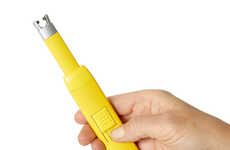
Finally's 14-Watt Eco Light Bulbs Emit More Light Than Incandescents
Laura McQuarrie — April 17, 2016 — Eco
References: finallybulbs & bizjournals
In addition to consuming less energy than 60-watt incandescents, Finally's 14-watt eco light bulbs shine brighter as well.
Now that the incandescent bulb has been phased out of stores, consumers have become familiar with many other eco-friendly lighting solutions. As a newcomer to the market, Finally set itself apart by promising 'No More Ugly Bulbs' with its "Acandescent" light bulbs.
The bulb looks exactly like an incandescent and shines even omnidirectional light. On the inside, the Acandescent technology uses a magnetic field rather than a filament or an electrode to generate light. As a result, the Finally Light Bulb emits the same warm and bright light as an incandescent but uses about 75% less energy.
Now that the incandescent bulb has been phased out of stores, consumers have become familiar with many other eco-friendly lighting solutions. As a newcomer to the market, Finally set itself apart by promising 'No More Ugly Bulbs' with its "Acandescent" light bulbs.
The bulb looks exactly like an incandescent and shines even omnidirectional light. On the inside, the Acandescent technology uses a magnetic field rather than a filament or an electrode to generate light. As a result, the Finally Light Bulb emits the same warm and bright light as an incandescent but uses about 75% less energy.
Trend Themes
1. Low-energy Lighting - The trend towards energy-saving lighting options presents opportunities for innovative lighting solutions that consume less energy while still emitting bright light.
2. Incandescent Replacement - The replacement of traditional incandescent light bulbs presents opportunities for lighting companies to develop eco-friendly, high-efficiency lighting solutions.
3. Acandescent Technology - The development of new lighting technologies such as Finally's Acandescent Light Bulb, which uses a magnetic field rather than a filament or electrode to generate light, presents opportunities for further innovation in lighting solutions.
Industry Implications
1. Lighting - The lighting industry has the potential to develop more efficient and eco-friendly lighting solutions that meet the needs of consumers and businesses.
2. Energy - The energy industry has the potential to benefit from the development of low-energy lighting solutions as a means to reduce energy consumption and promote sustainability.
3. Consumer Goods/retail - The consumer goods/retail industry can offer consumers new eco-friendly lighting solutions, like Finally's Acandescent Light Bulb, as a replacement for traditional incandescent bulbs.
2.5
Score
Popularity
Activity
Freshness























